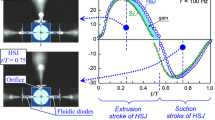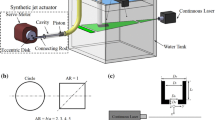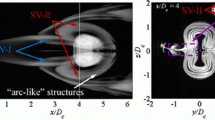Abstract
This experimental study deals with a round synthetic jet (SJ) issuing into quiescent surroundings. Flow visualization in air is used to identify different flow field regimes. Hot-wire anemometry and theoretical evaluations are used to quantify parameters in terms of the Reynolds (Re) and Stokes (S) numbers. To verify the theoretical evaluation, additional experiments were performed using the laser Doppler vibrometry. Four regimes of oscillatory suction and extrusion are distinguished and presented by means of a Re–S parameter map: (a) creeping flow without SJ formation, (b) SJ formation and propagation without vortex rollup, (c) SJ with vortex rollup, and (d) vortex structure breakdown, instability and transition to turbulence. Differences in the SJ regimes at low, moderate and high Stokes numbers are found. While all four (a–d) regimes are identified for lower (S < 10) and moderate (S = 10–30) Stokes numbers, the SJ formation process for higher Re and S is coupled with the laminar–turbulent transition. The results are reasonably consistent with those in the available literature.
Graphical Abstract










Similar content being viewed by others
References
Amitay M, Glezer A (2002) Controlled transients of flow reattachment over stalled airfoils. Int J Heat Fluid Fl 23:690–699
Arik M (2007) An investigation into feasibility of impingement heat transfer and acoustic abatement of meso scale synthetic jets. Appl Therm Eng 27:1483–1494
Ben Chiekh M, Bera JC, Sunyach M (2003) Synthetic jet control for flows in a diffuser: vectoring, spreading and mixing enhancement. J Turbul 4:1–12
BIPM, IEC, IFCC, IlAC, ISO, IUPAC, IUPAP, OIML (2008) Evaluation of measurement data—guide to the expression of uncertainty in measurement. Joint Committee for Guides in Metrology (JCGM 100:2008, GUM 1995 with minor corrections). http://www.bipm.org/utils/common/documents/jcgm/JCGM_100_2008_E.pdf
Cater JE, Soria J (2002) The evolution of round zero-net-mass-flux jets. J Fluid Mech 472:167–200
Chaudhari M, Puranik B, Agrawal A (2010) Heat transfer characteristics of synthetic jet impingement cooling. Int J Heat Mass Tran 53:1057–1069
Chen F-J, Beeler GB (2002) Virtual shaping of a two-dimensional NACA 0015 airfoil using synthetic jet actuator. AIAA Paper 2002-3273
Crook A, Wood NJ (2001) Measurements and visualisation of synthetic jets. AIAA Paper 2001-0145
Dauphinee TM (1957) Acoustic air pump. Ref Sci Instrum 28:456
Gallas Q, Holman R, Nishida T, Carroll B, Sheplak M, Cattafesta L (2003) Lumped element modeling of piezoelectric-driven synthetic jet actuators. AIAA J 41:240–247
Gillespie MB, Black WZ, Rinehart C, Glezer A (2006) Local convective heat transfer from a constant heat flux flat plate cooled by synthetic air jets. J Heat Transf Trans ASME 128:990–1000
Glezer A, Amitay M (2002) Synthetic jets. Annu Rev Fluid Mech 34:503–529
Goodfellow SD, Yarusevych S, Sullivan PE (2013) Smoke-wire flow visualization of a synthetic jet. J Vis 16:9–12
Holman R, Utturkar Y, Mittal R, Smith BL, Cattafesta L (2005) Formation criterion for synthetic jets. AIAA J 43:2110–2116
Hong G (2006) Effectiveness of micro synthetic jet actuator enhanced by flow instability on controlling laminar separation caused by adverse pressure gradient. Sens Actuator A Phys 132:607–615
James RD, Jacobs JW, Glezer A (1996) A round turbulent jet produced by an oscillating diaphragm. Phys Fluids 8:2484–2495
Kercher DS, Lee J-B, Brand O, Allen MG, Glezer A (2003) Microjet cooling devices for thermal management of electronics. IEEE Trans Compon Pack Manuf Technol 26:359–366
Kordík J, Trávníček Z (2013) Axisymmetric synthetic jet actuators with large streamwise dimensions. AIAA J 51(12):2862–2877
Kordík J, Broučková Z, Vít T, Pavelka M, Trávníček Z (2014) Novel methods for evaluation of the Reynolds number of synthetic jets. Exp Fluids 55:1757
Kral LD, Donovan JF, Cain AB, Cary AW (1997) Numerical simulation of synthetic jet actuators. AIAA Paper 97-1824
Lee CY, Goldstein DB (2002) Two-dimensional synthetic jet simulation. AIAA J 40:510–516
Lee A, Timchenko V, Yeoh GH, Reizes JA (2012a) Three-dimensional modelling of fluid flow and heat transfer in micro-channels with synthetic jet. Int J Heat Mass Tran 55:198–213. Erratum (2012) in Int J Heat Mass Tran 55:2746
Lee A, Yeoh GH, Timchenko V, Reizes JA (2012b) Flow structure generated by two synthetic jets in a channel: effect of phase and frequency. Sens Actuator A Phys 184:98–111
Mahalingam R, Rumigny N, Glezer A (2004) Thermal management using synthetic jet ejectors. IEEE Trans Compon Packag Technol 27:439–444
Mallinson SG, Reizes A, Hong G (2001) An experimental and numerical study of synthetic jet flow. Aeronaut J 105:41–49
McGuinn A, Farrelly R, Persoons T, Murray DB (2013) Flow regime characterisation of an impinging axisymmetric synthetic jet. Exp Therm Fluid Sci 47:241–251
Meier HU, Zhou M-D (1991) The development of acoustic generators and their application as a boundary-layer-transition control device. Exp Fluids 11:93–104
Milanovic IM, Zaman KBMQ (2005) Synthetic jets in crossflow. AIAA J 43:929–940
Mittal R, Rampunggoon P (2002) On the virtual aeroshaping effect of synthetic jets. Phys Fluids 14:1533–1536
Ng I, Timchenko V, Reizes J, Trávníček Z, Kordík J, Broučková Z (2013) Synthetic jets at low Stokes number: numerical and experimental approach. In: Tenth International Conference on Flow Dynamics OS7-8:472–473, Sendai
Pack LG, Seifert A (2001) Periodic excitation for jet vectoring and enhanced spreading. J Aircraft 38:486–495
Persoons T, McGuinn A, Murray DB (2011) A general correlation for the stagnation point Nusselt number of an axisymmetric impinging synthetic jet. Int J Heat Mass Tran 54:3900–3908
Shuster JM, Smith DR (2007) Experimental study of the formation and scaling of a round synthetic jet. Phys Fluids 19:045109
Smith BL, Glezer A (1998) The formation and evolution of synthetic jets. Phys Fluids 10:2281–2297
Smith BL, Glezer A (2002) Jet vectoring using synthetic jets. J Fluid Mech 458:1–34
Smith BL, Swift GW (2003) A comparison between synthetic jets and continuous jets. Exp Fluids 34:467–472
Tamburello DA, Amitay M (2007) Three-dimensional interactions of a free jet with a perpendicular synthetic jet. J Turbul 8:1–18
Tensi J, Boué I, Paillé F, Dury G (2002) Modification of the wake behind a circular cylinder by using synthetic jets. J Vis 5:37–44
Timchenko V, Reizes J, Leonardi E, de Vahl Davis G (2004) A criterion for the formation of micro synthetic jets. In: Proceedings of IMECE04, IMECE2004-61374 260:197–203, New York
Timchenko V, Reizes JA, Leonardi E (2007) An evaluation of synthetic jets for heat transfer enhancement in air cooled micro-channels. Int J Numer Methods Heat Fluid Flow 17:263–283
Trávníček Z, Tesař V (2003) Annular synthetic jet used for impinging flow mass-transfer. Int J Heat Mass Tran 46:3291–3297
Trávníček Z, Vít T, Tesař V (2006) Hybrid synthetic jets as the non-zero-net-mass-flux synthetic jets. Phys Fluids 18:081701
Trávníček Z, Broučková Z, Kordík J (2012a) Formation criterion for axisymmetric synthetic jets at high Stokes numbers. AIAA J 50(9):2012–2017
Trávníček Z, Němcová L, Kordík J, Tesař V, Kopecký V (2012b) Axisymmetric impinging jet excited by a synthetic jet system. Int J Heat Mass Tran 55:1279–1290
Trávníček Z, Dančová P, Kordík J, Vít T, Pavelka M (2012c) Heat and mass transfer caused by a laminar channel flow equipped with a synthetic jet array. Trans ASME J Thermal Sci Eng Appl 2:041006-1–041006-8
Trávníček Z, Broučková Z, Kordík J (2013) Visualization of synthetic jet formation in air. In: 12th International Symposium on Fluid Control, Measurement and Visualization FLUCOME2013 OS6-02-2, Nara
Valiorgue P, Persoons T, McGuinn A, Murray DB (2009) Heat transfer mechanisms in an impinging synthetic jet for a small jet-to-surface spacing. Exp Therm Fluid Sci 33:597–603
Watson GMG, Sigurdson LW (2008) The controlled relaminarization of low velocity ratio elevated jets-in-crossflow. Phys Fluids 20:094108
Xia Q, Zhong S (2012a) An experimental study on the behaviours of circular synthetic jets at low Reynolds numbers. Proc Inst Mech Eng Part C J Eng Mech Eng Sci 226:2686–2700
Xia Q, Zhong S (2012b) A PLIF and PIV study of liquid mixing enhanced by a lateral synthetic jet pair. Int J Heat Fluid Flow 37:64–73
Xia Q, Lei S, Ma J, Zhong S (2014) Numerical study of circular synthetic jets at low Reynolds numbers. Int J Heat Fluid Flow 50:456–466
Yassour Y, Stricker J, Wolfshtein M (1986) Heat transfer from a small pulsating jet. In: Proceedings of 8th International Heat Transfer Conference 3:1183–1186, San Francisco
Yehoshua T, Seifert A (2006) Boundary condition effects on the evolution of a train of vortex pairs in still air. Aeronaut J 110:397–417
Zhou J, Tang H, Zhong S (2009) Vortex roll-up criterion for synthetic jets. AIAA J 47:1252–1262
Acknowledgments
We gratefully acknowledge the support from the Grant Agency CR—the Czech Science Foundation (Project No. 14-08888S) and the institutional support RVO: 61388998.
Author information
Authors and Affiliations
Corresponding author
Appendices
Appendix A: Relative uncertainties of the Reynolds and Stokes numbers
Uncertainty analysis was performed according to the guidelines of BIMP et al. (2008).
Uncertainties of the Reynolds number
For the Reynolds number based on the hot-wire experiment, errors in nozzle diameter, temperature, barometric pressure were estimated at 0.04 mm, 0.7, and 1.5 %, respectively. The error resulting from the temperature loading effect was 6.1 %. The calibration errors were estimated at 1.0–10.8 %, depending on the velocity. Finally, the typical relative uncertainties of the Reynolds numbers were within 17.2 and 10.7 % for experiments with nozzle diameters of D = 1.5 mm and D = 5 mm, respectively. The evaluation was made for cases Figs. 4b and 3d from Table 1, respectively. The confidence level of the uncertainties was 95 %.
For the Reynolds number based on the theoretical evaluation, errors in nozzle diameter, the effective diameter of the diaphragm, temperature, and barometric pressure were estimated at 0.04 mm, 3.8, 0.7, and 1.5 %, respectively. The diaphragm velocity errors were estimated at 16.1 % and 6.0 % for evaluations with nozzle diameters of D = 1.5 mm and D = 5 mm, respectively. Finally, the relative uncertainties of the Reynolds numbers were within 18.3 and 10.1 % for evaluations with nozzle diameters of D = 1.5 mm and D = 5 mm, respectively. The confidence level of the uncertainties was 95 %.
For the Reynolds number based on the LDV experiment, errors in nozzle diameter, the effective diameter of the diaphragm, temperature, and barometric pressure were estimated at 0.04 mm, 3.8, 0.7, and 1.5 %, respectively. Finally, the relative uncertainties of the Reynolds numbers were within 8.7 and 7.8 % for experiments with nozzle diameters of D = 1.5 mm and D = 5 mm, respectively. The confidence level of the uncertainties was 95 %.
Uncertainties of the Stokes number
For the Stokes number evaluation, errors in nozzle diameter, temperature, and barometric pressure were estimated at 0.04 mm, 0.7, and 1.5 %, respectively. Finally, the Stokes number relative uncertainties were within 4.0 and 1.6 % for experiments with nozzle diameters of D = 1.5 mm and D = 5 mm, respectively. The confidence level of the uncertainties was 95 %.
Appendix B: Sinusoidal character of the diaphragm and SJ flow oscillations
The diaphragm surface velocity was measured using laser Doppler vibrometry (LDV). Assuming the continuity equation, incompressibility, a rigid (piston-like) diaphragm, and the slug flow model, the velocity at the orifice (u 0) was evaluated during the driven cycle—see the curve marked as “u 0, LDV evaluation” in Fig. 10. This velocity was found to be very close to the ideal sine waveform, as Fig. 10 illustrates. To quantify the very small differences, the crest factors of both curves were calculated. For the u 0 curve and for the ideal sine curve, the crest factors were 1.44 and 20.5, respectively—i.e., the difference in both was only 1.8 %. It can be concluded that direct LDV measurement of the diaphragm velocity confirms the sinusoidal character of the diaphragm oscillations.
Unlike the sinusoidal character of the diaphragm oscillations, the velocity cycle generated by the SJ actuator can exhibit significant deviations from a sinusoidal character, resulting from the fluid dynamics during SJ formation. Namely, the flow field patterns of the extrusion and suction strokes are basically different. While the extrusion stroke generates a streamwise velocity component (and a radial entrainment component is of lesser importance), the flow field during the suction stroke assumes the characteristics of a three-dimensional (centripetal) sink. Therefore, the velocity vectors are inclined towards the axis in the off-axis regions during the suction stroke. To demonstrate these effects for the present SJ actuator, a hot-wire velocity measurement was performed at the SJ actuator orifice (x = 0, r = 0). Figure 10 shows the results as the U + U P velocity—see “U + U P, CTA measurement” curve. During the extrusion stroke, the U + U P curve corresponds reasonably well with the LDV evaluation. It is worth noting here that this agreement is important for evaluation of the Reynolds number. Namely, the Re is based on the time-mean orifice velocity U 0, which is defined solely from the extrusion stroke—see Eq. (1).
On the other hand, there were evident differences between the curves, “U + U P, CTA measurement” and “u 0, LDV evaluation”, during the suction stroke. This effect demonstrates the above mentioned three-dimensional character of the suction stroke.
Another meaningful effect was an occurrence of around-zero gaps on the U + U P curve between the extrusion and suction strokes. These gaps are typical for all hot-wire measurements of SJs. They indicate that the velocity magnitude is below the low end of the hot-wire calibration range—see Smith and Glezer (1998). However, a link-up between the extrusion and suction strokes is usually a rather smooth line, occurring near the ideal sine curve. Surprisingly, Fig. 10 shows a deflecting tendency of the U + U P curve near these gaps. Apparently, this effect is linked with the present low Reynolds numbers because no similar effect was observed at a higher Re range—cf. SJ experiments by Trávníček et al. (2006) at Re = 8,200. An estimation of a more probable link-up over these gaps is shown by the dotted (near-sine) lines in Fig. 10. Note that this effect is negligible for evaluation of the time-mean orifice velocity U 0.
Rights and permissions
About this article
Cite this article
Trávníček, Z., Broučková, Z., Kordík, J. et al. Visualization of synthetic jet formation in air. J Vis 18, 595–609 (2015). https://doi.org/10.1007/s12650-015-0273-2
Received:
Revised:
Accepted:
Published:
Issue Date:
DOI: https://doi.org/10.1007/s12650-015-0273-2





